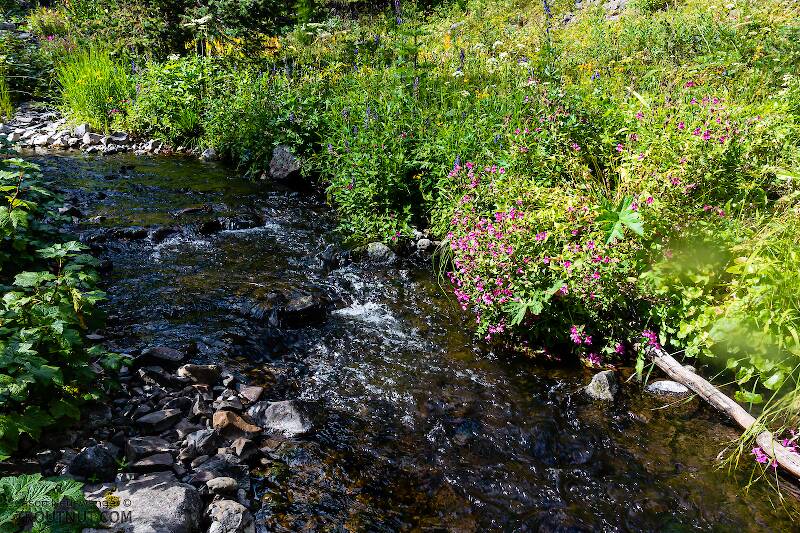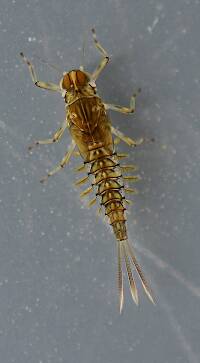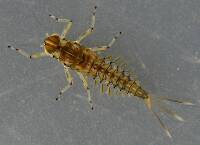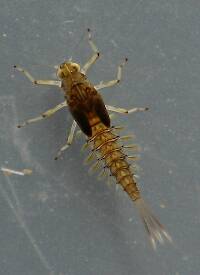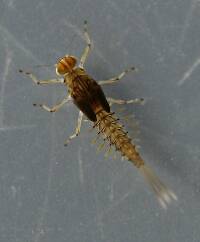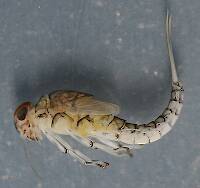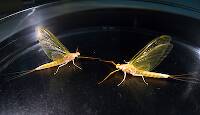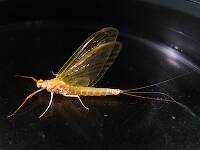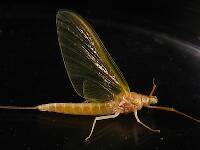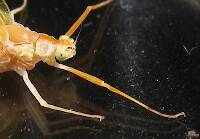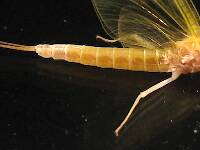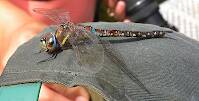
Hex Mayflies
Hexagenia limbata
The famous nocturnal Hex hatch of the Midwest (and a few other lucky locations) stirs to the surface mythically large brown trout that only touch streamers for the rest of the year.
Featured on the forum

This is the first of it's family I've seen, collected from a tiny, fishless stream in the Cascades. The three species of this genus all live in the Northwest and are predators that primarily eat stonefly nymphs Merritt R.W., Cummins, K.W., and Berg, M.B. (2019).

Troutnut is a project started in 2003 by salmonid ecologist Jason "Troutnut" Neuswanger to help anglers and
fly tyers unabashedly embrace the entomological side of the sport. Learn more about Troutnut or
support the project for an enhanced experience here.
GONZO on Apr 12, 2007April 12th, 2007, 3:39 am EDT
A few years back, I was looking through a friend's copy of B. D. Burks' "The Mayflies or Ephemeroptera of Illinois." I was looking for some answers to some identification issues, and even though many revisions have occurred since its publication, it was very helpful. But the thing that stuck in my mind ever since was his commentary about introduced trout in New Zealand.
Although I've never had the privilege of fishing there, I've read two things about the fishing that stand out. First, though the trout can be huge, they are generally not numerous, especially in streams. Second, there are very few significant mayfly hatches to match. Until I read Burks, I had just assumed that mayflies were never very common in NZ.
According to Burks, my assumption was erroneous. He said that because the mayfly species in NZ hadn't evolved with the trout, they lacked specific defenses and the introduced trout simply ate most of them! It made sense, but this was the only place where I had read that. I was wondering what some of our insect/trout experts thought about this, and whether similar things have been documented in South America or other places where trout have been introduced.
Although I've never had the privilege of fishing there, I've read two things about the fishing that stand out. First, though the trout can be huge, they are generally not numerous, especially in streams. Second, there are very few significant mayfly hatches to match. Until I read Burks, I had just assumed that mayflies were never very common in NZ.
According to Burks, my assumption was erroneous. He said that because the mayfly species in NZ hadn't evolved with the trout, they lacked specific defenses and the introduced trout simply ate most of them! It made sense, but this was the only place where I had read that. I was wondering what some of our insect/trout experts thought about this, and whether similar things have been documented in South America or other places where trout have been introduced.
Konchu on Apr 12, 2007April 12th, 2007, 5:11 am EDT
Introduction of trout above waterfalls in parts of western North America have been hard on some aquatic insects.
GONZO on Apr 15, 2007April 15th, 2007, 3:33 am EDT
Hi David,
It's been a while since I read Burks' comments (and I really don't trust my memory the way I once did). I'm trying to recall if he made any comments about native fishes relative to this. I think he did, but I can't be sure. Anyway, it's possible that I've overstated his case. I even suppose it's possible that Burks overstated the case, but that error is much more likely to be mine than his. ;)
It's been a while since I read Burks' comments (and I really don't trust my memory the way I once did). I'm trying to recall if he made any comments about native fishes relative to this. I think he did, but I can't be sure. Anyway, it's possible that I've overstated his case. I even suppose it's possible that Burks overstated the case, but that error is much more likely to be mine than his. ;)
Quick Reply
Related Discussions
Topic
Replies
Last Reply
14
Jun 15, 2012
by Entoman
by Entoman
2
Mar 20, 2007
by Taxon
by Taxon

